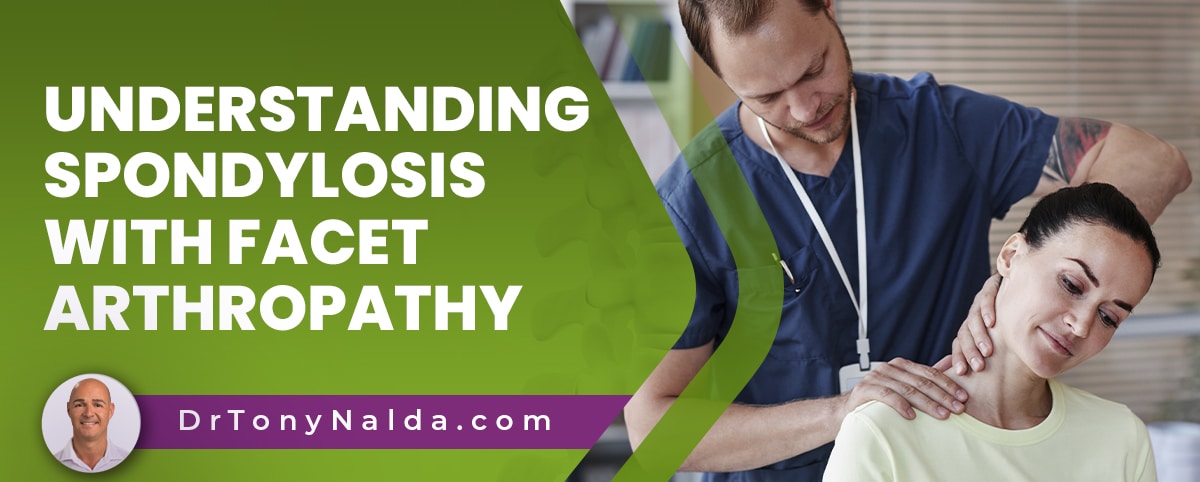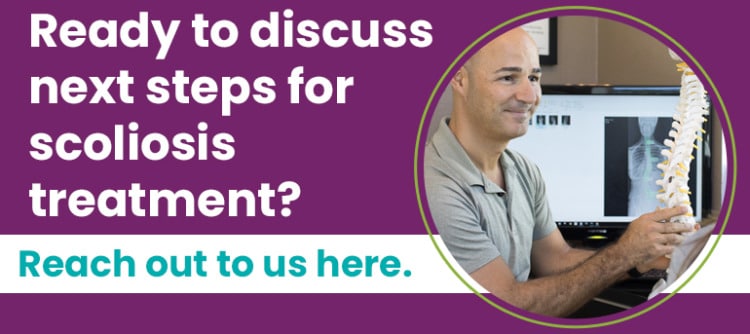Understanding Spondylosis with Facet Arthropathy

Spondylosis with facet arthropathy is a type of spinal arthritis affecting the spine's facet joints that connect the vertebrae (bones of the spine). The facet joints combine forces to facilitate flexibility, but also prevent too much movement within the spine.
Spondylosis is a term referencing general degenerative changes in the spine, and spondylosis with facet arthropathy is a further specification that the facet joints are degenerating and becoming arthritic.
To better understand the role of the facet joints, let's talk generally about the spine's structure.
Table of Contents
Anatomy of the Spine
The spine has three main sections: the cervical spine (neck), thoracic spine (middle/upper back), and the lumbar spine (lower back).
The spine is curved in each of its main sections, and these curves keep the spine strong, flexible, and make it easier to absorb and distribute mechanical stress, and the health of the entire spine is shaped by its natural curves and alignment.
Curves sizes can vary from person to person, but if a curve size doesn't fall within a normal range, the biomechanics of the entire spine can be disrupted.
Spinal Discs
An intervertebral disc sits between adjacent vertebrae, and the discs facilitate the spine's flexibility, structure, provide cushioning, and act as the spine's shock absorbers.
So the spinal discs are also part of the spine's ability to move while maintaining strength and structure, and not bending or twisting too far.
Most spinal degeneration starts in the discs; degenerative disc disease is a contributing factor in the development of a number of spinal conditions/issues.
If the spine is aligned, this means its vertebrae are stacked on top of one another in a straight and neutral alignment, but if it's not aligned, this disrupts the spine's balance, causing spinal instability.
 Facet joints are small joints that connect the vertebrae; they act like hinges so the spine can bend and twist while not allowing for a harmful level of movement.
Facet joints are small joints that connect the vertebrae; they act like hinges so the spine can bend and twist while not allowing for a harmful level of movement.
The facet joints are important for mobility and structure.
Facet Joint Function
The facet joints are important for a number of reasons. The spine's natural design is movement-based, and the individual parts of the spine work together to allow for healthy movement patterns and ranges of motion.
So the facet joints allow for movement while still providing structure, and as the brain and spine work together as the central nervous system, the facet joints also protect the 31 pairs of spinal nerves that make up the spinal cord.
The facet joints allow for movement, stability, are weight-bearing and preserve nerve function.
They allow for movement by facilitating flexion, extension, lateral flexion, and rotation, but they also help with stability by preventing the spine from bending or twisting too far; this stability is also key to nerve health and function.
The facet joints are also weight-bearing so help take pressure off the spine during strenuous movement; they work with the intervertebral discs to distribute forces evenly throughout the spine.
Spondylosis with Facet Arthropathy
 Spondylosis means spinal degeneration, and as mentioned, this most often starts with the discs, and if spondylosis is further specified with facet arthropathy, it's the facet joints in particular that are degenerating to the point of becoming arthritic.
Spondylosis means spinal degeneration, and as mentioned, this most often starts with the discs, and if spondylosis is further specified with facet arthropathy, it's the facet joints in particular that are degenerating to the point of becoming arthritic.
Oftentimes, the discs start to degenerate first, and this causes them to change shape and strain the facet joints.
If the discs aren't functioning as well, because they work in conjunction with the facet joints, this means the joints have to work harder, making them vulnerable to strain and injury.
Spondylosis and facet arthropathy are part of natural age-related spinal degeneration, and a range of symptoms can include back pain, neck pain, stiffness in the back and/or neck, pain that worsens with certain position changes, and radiating pain into the buttocks, thighs, arms, and head.
The vertebrae don't just facilitate movement, the tunnel they form houses the spinal cord, so if the spine and its facet joints are degenerating, it can also affect the spinal nerves within, and if a nerve is exposed to any kind of uneven pressure, it can become compressed, inflamed, irritated, and/or impinged.
Facet Joint Arthropathy Symptoms
So if a facet joint becomes inflamed and presses on a nearby nerve, pain and a number of sensations can be felt anywhere along the compressed nerve's pathway, hence pain felt in areas of the body other than the back.
Pain caused by facet joint arthropathy can be sharp, dull, or involve intermittent stabbing pains. It's common for pain to increase after standing for extended periods of time, while bending backward, or twisting.
Increasing stiffness in the spine can also affect movement, and if left untreated and/or when severe, changes to gait and balance can occur.
Is Spondylosis Preventable?
The spine, just like the rest of the body, is subject to degenerative changes with increasing age, but there are certain lifestyle factors that can shape a person's level and rate of spinal degeneration.
And just as spinal degeneration can occur slowly over the years, certain lifestyle factors can also cumulatively affect spinal health and function.
So while spinal degeneration is natural and age-related, there are additional variables that can strengthen or weaken a spine, making it less or more vulnerable to injury and/or degenerative forces.
Most spinal degeneration starts with the intervertebral discs, and a disc sits between adjacent vertebrae providing cushioning, structure, flexibility, and acts as the spine's shock absorbers.
Preserving Disc Health
The spine's overall health is affected by disc health, so lifestyle factors that preserve disc health and function can help.
Maintaining a healthy weight and activity level are important. Carrying more weight means more pressure and strain on the body's joints, including the spine, and the spine's individual structures, including the discs.
Staying active can mean a stronger core for more spinal support and stability, and it can also mean increased blood flow around the discs, and this is key to disc health because the discs don't have their own vascular supply.
So improving circulation through movement can mean the discs staying nourished as they can absorb what they need for their surroundings.
Staying hydrated is also important for disc health. When we're born, the discs are made largely of water, but as we age, fluid levels decrease, and if/when a disc becomes desiccated, it can change shape and affect the area in a number of ways, one of which is causing uneven wear and tear on the spine.
Any type of uneven force experienced by the spine, if left unaddressed, can have the cumulative effect of uneven weight distribution and/or increase natural wear and tear on the spine.
Understanding the ergonomics of proper lifting can also help preserve spinal health and function, and practicing good posture is also key.
As always, a healthy diet also has a number of benefits, including a diet that's high in calcium and Vitamin D, known to promote bone strength and health.
Conclusion
Spondylosis is spinal degeneration, and spondylosis with facet joint arthropathy means the degeneration and arthritic changes have occurred in the vertebrae's facet joints.
The spine's facet joints connect the bones of the spine, so they are key to maintaining the spine's healthy curves and alignment.
Facet joint arthropathy is also known as facet joint arthritis or simply facet syndrome and involves the facet joints becoming painful and inflamed; this is most often caused by osteoarthritis of the spine.
The facet joints are located at the back of the spine and also provide stability and mobility, while preventing the spine from twisting or bending excessively far.
Symptoms of spondylosis with facet arthropathy can include back pain, stiffness, and a limited range of motion.
While certain spinal conditions and injuries are unavoidable, there are a number of lifestyle factors that affect spinal health and function, so leading a spine-friendly lifestyle can help prevent/slow natural age-related spinal degeneration, and when it comes to facet pain, physical therapy can help with pain management.
The best way to prevent spinal degeneration and disc desiccation is to stay hydrated, active, maintain a healthy weight and diet, practice good posture, and be mindful of how to lift heavy objects correctly without straining the spine.
Here at the Scoliosis Reduction Center®, we specialize in non surgical treatments for a number of spinal conditions, spondylosis with facet arthropathy included.
Dr. Tony Nalda
DOCTOR OF CHIROPRACTIC
After receiving an undergraduate degree in psychology and his Doctorate of Chiropractic from Life University, Dr. Nalda settled in Celebration, Florida and proceeded to build one of Central Florida’s most successful chiropractic clinics.
His experience with patients suffering from scoliosis, and the confusion and frustration they faced, led him to seek a specialty in scoliosis care. In 2006 he completed his Intensive Care Certification from CLEAR Institute, a leading scoliosis educational and certification center.
About Dr. Tony Nalda
 Ready to explore scoliosis treatment? Contact Us Now
Ready to explore scoliosis treatment? Contact Us Now





